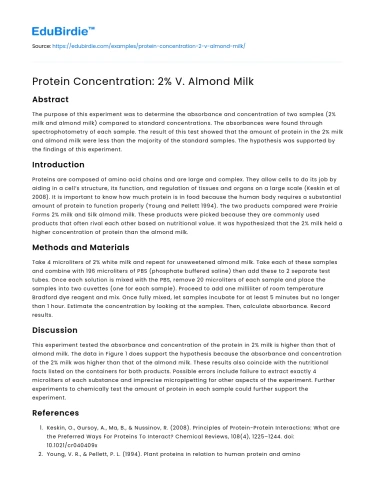Abstract
The purpose of this experiment was to determine the absorbance and concentration of two samples (2% milk and almond milk) compared to standard concentrations. The absorbances were found through spectrophotometry of each sample. The result of this test showed that the amount of protein in the 2% milk and almond milk were less than the majority of the standard samples. The hypothesis was supported by the findings of this experiment.
Introduction
Proteins are composed of amino acid chains and are large and complex. They allow cells to do its job by aiding in a cell’s structure, its function, and regulation of tissues and organs on a large scale (Keskin et al 2008). It is important to know how much protein is in food because the human body requires a substantial amount of protein to function properly (Young and Pellett 1994). The two products compared were Prairie Farms 2% milk and Silk almond milk. These products were picked because they are commonly used products that often rival each other based on nutritional value. It was hypothesized that the 2% milk held a higher concentration of protein than the almond milk.
Save your time!
We can take care of your essay
- Proper editing and formatting
- Free revision, title page, and bibliography
- Flexible prices and money-back guarantee
Methods and Materials
Take 4 microliters of 2% white milk and repeat for unsweetened almond milk. Take each of these samples and combine with 196 microliters of PBS (phosphate buffered saline) then add these to 2 separate test tubes. Once each solution is mixed with the PBS, remove 20 microliters of each sample and place the samples into two cuvettes (one for each sample). Proceed to add one milliliter of room temperature Bradford dye reagent and mix. Once fully mixed, let samples incubate for at least 5 minutes but no longer than 1 hour. Estimate the concentration by looking at the samples. Then, calculate absorbance. Record results.
Discussion
This experiment tested the absorbance and concentration of the protein in 2% milk is higher than that of almond milk. The data in Figure 1 does support the hypothesis because the absorbance and concentration of the 2% milk was higher than that of the almond milk. These results also coincide with the nutritional facts listed on the containers for both products. Possible errors include failure to extract exactly 4 microliters of each substance and imprecise micropipetting for other aspects of the experiment. Further experiments to chemically test the amount of protein in each sample could further support the experiment.
References
- Keskin, O., Gursoy, A., Ma, B., & Nussinov, R. (2008). Principles of Protein−Protein Interactions: What are the Preferred Ways For Proteins To Interact? Chemical Reviews, 108(4), 1225–1244. doi: 10.1021/cr040409x
- Young, V. R., & Pellett, P. L. (1994). Plant proteins in relation to human protein and amino acid nutrition. The American Journal of Clinical Nutrition, 59(5). doi: 10.1093/ajcn/59.5.1203s
Did you like this example?
Make sure you submit a unique essay
Our writers will provide you with an essay sample written from scratch: any topic, any deadline, any instructions.
Cite this paper
-
APA
-
MLA
-
Harvard
-
Vancouver
Protein Concentration: 2% V. Almond Milk.
(2022, February 17). Edubirdie. Retrieved March 3, 2025, from https://edubirdie.com/examples/protein-concentration-2-v-almond-milk/
“Protein Concentration: 2% V. Almond Milk.” Edubirdie, 17 Feb. 2022, edubirdie.com/examples/protein-concentration-2-v-almond-milk/
Protein Concentration: 2% V. Almond Milk. [online].
Available at: <https://edubirdie.com/examples/protein-concentration-2-v-almond-milk/> [Accessed 3 Mar. 2025].
Protein Concentration: 2% V. Almond Milk [Internet]. Edubirdie.
2022 Feb 17 [cited 2025 Mar 3].
Available from: https://edubirdie.com/examples/protein-concentration-2-v-almond-milk/
copy






 Stuck on your essay?
Stuck on your essay?

